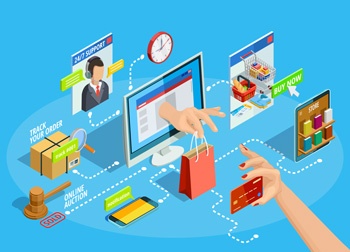As consumers, we tend to gravitate towards buying experiences that are easy, trustworthy, and personalized.
B2C E-commerce
We’ve grown accustomed to great online experiences in our personal lives, through our interactions with the advanced business-to-consumer (B2C) e-commerce sites of some of the top retailers. These experiences have also raised our expectations that (despite the added complexity) business-to-business (B2B) e-commerce experiences should be just as good.
Because of these expectations, consumer goods companies and manufacturers are challenged to establish flexible multichannel e-commerce platforms to meet the distinct demands of B2B, B2C and sometimes, B2B2C channels.
For these companies to solve this puzzle, delivering a B2C-style e-commerce experience is not just a defensive tactic: It also offers a huge growth opportunity.
For example, Forrester forecasts B2B e-commerce will become a $1.13 trillion market by 2020. Mondelēz International, for example, has publicly proclaimed its intention to grow its current B2B e-commerce revenue of about $100 million to $1 billion within a decade.
There are numerous benefits of executing B2B e-commerce well, including the following.
For the B2B Buyer
For the B2B Company
- Faster and easier purchasing processes
- Personalized and relevant searches and details, including products, price and service information
- A seamless and consistent experience across channels
- Always up to date and readily accessible product and inventory information
- Improved control with self-service access to account information
- Accurate updates about the status of orders
- Automation of routine ordering, customer service and sales processes, freeing up sales for higher value activities
- Cross-channel sales and fulfillment efficiency
- Streamlined delivery processes
- Access to more complete customer data for analysis
- Customer perception of the brand as competitive and technology-forward
Aberdeen Group observes, “By initiating a digital business transformation to B2B/B2C order flows by customer you can improve order throughput, obtain 100% accuracy, and reduce manual intervention. You can also compete with 2 day delivery standards to capture the hidden ROI associated with negative cash-to-cash conversion cycles.”
The Reality
But a lot must happen beneath the surface to make B2B e-commerce experiences as simple, fast and seamless as B2C. Forrester also asserts that B2B e-commerce organizations must address the growing demand for B2C-like B2B e-commerce experiences as well as channel conflict between direct sales organizations and e-commerce operations.
Another consideration is that one-time “captured” B2B customers are now digitally empowered. As a result, they are now loyal only to pricing and experience – wherever they may find them. Creating a B2B e-commerce experience that delivers on all of those expectations requires not just shrewd selection and integration of the right technical underpinnings, but strong process and change management leadership as well.
The Complexities of B2B E-Commerce
Consumer Goods and manufacturing companies with B2B channels struggle to live up to the B2C bar for many reasons.
While a B2C transaction is generally linear, a B2B purchase typically involves a number of considerations that make it challenging to deliver a great experience, including:
- complex purchasing processes
- contracts with specific pricing and payment terms
- configurable and segmented product assortments
- sales force involvement and commissions
- approval processes specific to a customer or segment of customers
Furthermore, some product categories, such as automotive products, batteries, perfume and pharmaceuticals, have regulatory or shipping restrictions as well as different sales models. Many B2B companies also use one or more B2B sales channels, including a direct sales force, distributors, dealers, franchises, and independent sales agencies.
In addition, B2B buyers have their own purchasing rules and spending limits and must often collaborate among multiple decision-makers and contacts for approvals. Consider a feature such as search. Search is already a complex and performance-sensitive function in B2C, significantly impacting customer experiences and purchase patterns. B2B adds layers of rules according to the user, business unit, account terms, and more, which must be applied with a high degree of accuracy to return proper results. Similarly, many current B2B e-commerce platforms cannot support long page scroll because of incompatibilities with rules engines.
Other challenges include coordinating pricing and promotions with channel partner sites and supporting cross-channel inventory, orders, and returns.
B2B Experience
Despite all of this, the customer expects the B2B seller to offer a simple, intuitive, and visually oriented online experience, via laptop, tablet, or mobile phone. If the B2B site experience is painful, even a significant price difference often does little to stop a business buyer from gravitating toward something more comfortable, even a B2C website. B2B customers, and even a firm’s own employees, are no longer a captive audience that will put up with yesterday’s “good enough” ordering system.
Delivering a satisfactory B2B e-commerce experience is not just about an elegant user interface or the online experience itself. It must be supported by a well-orchestrated array of technologies and processes, from content and customer relationship management to order management and fulfillment. It requires a number of key capabilities, from personalization, to inventory visibility, to seamless, end-to-end fulfillment and returns processes.
We’ll explore these capabilities and technologies in future blog posts.
For now, if you wish to learn more on this topic, check out this white paper from Eliassen Group and Consumer Goods Technology.


